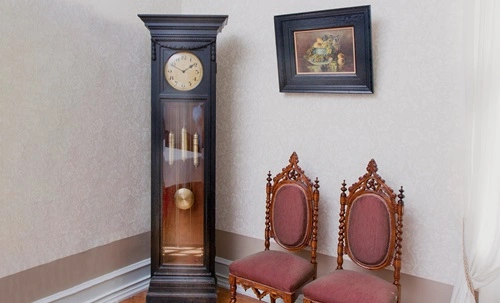Grandfather and grandmother clocks are iconic timepieces that have adorned homes for centuries. Known for their elegance and timeless appeal, these clocks are prized for their intricate craftsmanship and ability to add charm to any space. While both clocks share similar features and designs, there are distinct differences that set them apart.
This article delves into the difference between a grandfather clock and a grandmother clock, exploring their origins, dimensions, styles, and functional attributes to help you understand their unique characteristics.
What Is a Grandfather Clock?

A grandfather clock, also known as a longcase clock or floor clock, is a tall, freestanding timepiece with a pendulum mechanism enclosed within a wooden case. These clocks are synonymous with elegance and tradition, often serving as statement pieces in homes.
Key Features of Grandfather Clocks:
- Height: Typically between 6 and 8 feet tall.
- Design: Often ornate, with intricate carvings, inlays, and a dominant presence.
- Mechanism: Operates using a pendulum and weights that control the clock’s movement.
- Sound: Many models include chimes, such as the Westminster chime, which strike at specific intervals.
History of the Grandfather Clock
The term “grandfather clock” originated from the 1876 song “My Grandfather’s Clock” by Henry Clay Work, which described a longcase clock that stopped working upon the death of its owner. However, these clocks date back to the late 17th century and were developed in England as a result of advancements in pendulum technology by Christiaan Huygens.
What Is a Grandmother Clock?
A grandmother clock is a smaller version of a grandfather clock, designed to offer the same aesthetic appeal while fitting into more compact spaces. These clocks maintain the classic longcase style but are scaled down in size and often simpler in design.
Key Features of Grandmother Clocks:
- Height: Typically between 5 and 6 feet tall.
- Design: More compact and less elaborate than grandfather clocks, making them suitable for smaller rooms.
- Mechanism: Uses the same pendulum-driven mechanism as a grandfather clock.
- Sound: May also include chimes, though some models are quieter.
History of the Grandmother Clock
Grandmother clocks emerged as a practical alternative to the towering grandfather clocks, catering to those who wanted the elegance of a longcase clock without the imposing size. They became especially popular in the 18th and 19th centuries as homes became smaller and more modestly furnished.
Key Differences Between Grandfather and Grandmother Clocks
| Aspect | Grandfather Clock | Grandmother Clock |
|---|---|---|
| Height | 6 to 8 feet tall. | 5 to 6 feet tall. |
| Design | Large, ornate, and dominant in presence. | Compact, understated, and simpler in design. |
| Weight and Size | Heavier and requires more floor space. | Lighter and better suited for smaller spaces. |
| Historical Popularity | Originated in the late 17th century and became iconic in large homes. | Emerged as a space-saving alternative in smaller homes. |
| Chime Mechanism | Often includes multiple chime options and elaborate sound mechanisms. | May have simpler or fewer chime options. |
| Cost | Generally more expensive due to size and craftsmanship. | Typically more affordable due to smaller size and simpler designs. |
| Placement | Best suited for spacious rooms or entryways. | Ideal for compact spaces such as smaller living rooms or bedrooms. |
Dimensions and Placement
Grandfather Clocks
- Dimensions: The taller stature of a grandfather clock requires rooms with high ceilings and ample floor space.
- Placement: Typically placed in large living rooms, hallways, or formal dining rooms where they can serve as focal points.
Grandmother Clocks
- Dimensions: With a more modest height, grandmother clocks can fit comfortably in smaller spaces.
- Placement: Perfect for cozier settings like bedrooms, smaller living areas, or apartments.
Style and Aesthetics
Grandfather Clocks
- Grandfather clocks are often more ornate and elaborate, featuring detailed carvings, brass or gold accents, and decorative clock faces.
- These clocks are associated with a more formal, traditional aesthetic and are often considered heirloom pieces.
Grandmother Clocks
- Grandmother clocks are generally simpler in design, with clean lines and less intricate detailing.
- They blend well with both traditional and contemporary décor, making them versatile for various interior styles.
Functionality and Features
Mechanism
Both grandfather and grandmother clocks operate using a pendulum mechanism powered by weights or springs. However, the scale of the mechanism may differ slightly due to their size.
Chimes
- Grandfather Clocks: Often equipped with complex chime systems that can play multiple melodies at different intervals, such as every 15 minutes or hourly.
- Grandmother Clocks: Typically have simpler chime systems, and some may even forgo chimes altogether for a quieter operation.
Durability
Both types of clocks are designed to last for generations with proper maintenance, though grandfather clocks may require more robust care due to their size and complexity.
Cost and Investment
Grandfather Clocks
- Due to their size, materials, and craftsmanship, grandfather clocks are usually more expensive.
- Antique or high-end grandfather clocks can be significant investments, often sought after by collectors.
Grandmother Clocks
- Grandmother clocks are generally more affordable, making them a practical option for those who want the elegance of a longcase clock without the hefty price tag.
- While they may not hold the same collectible value as grandfather clocks, they are still cherished decorative and functional pieces.
Choosing Between a Grandfather and Grandmother Clock
When deciding between a grandfather and a grandmother clock, consider the following factors:
- Space: If you have a spacious room with high ceilings, a grandfather clock can serve as an impressive focal point. For smaller spaces, a grandmother clock is more practical.
- Budget: Grandmother clocks are typically more affordable, making them ideal for those on a budget.
- Aesthetic Preference: Grandfather clocks offer a bold and ornate appearance, while grandmother clocks provide a subtler, versatile charm.
- Purpose: If you’re looking for a functional timepiece with a decorative element, either clock will suffice. However, collectors and traditionalists may gravitate toward the grandeur of a grandfather clock.
Maintenance and Care
Both grandfather and grandmother clocks require regular maintenance to ensure they function smoothly and maintain their aesthetic appeal. Key maintenance tasks include:
- Regular Winding: Both types of clocks need to be wound regularly, depending on the mechanism (weekly or biweekly).
- Dusting: Clean the wooden case and clock face gently to prevent dust buildup.
- Professional Servicing: Periodic servicing by a clockmaker is essential for keeping the internal mechanisms in good condition.
Conclusion
While both grandfather clocks and grandmother clocks share a rich history and timeless appeal, their differences lie primarily in their size, design, and placement. Grandfather clocks are ideal for those who want a bold, statement piece in a spacious room, while grandmother clocks offer a compact and versatile option for smaller spaces.
Ultimately, the choice between the two comes down to personal preference, available space, and budget. Whichever you choose, these elegant timepieces are sure to enhance the charm and character of your home for generations to come.



